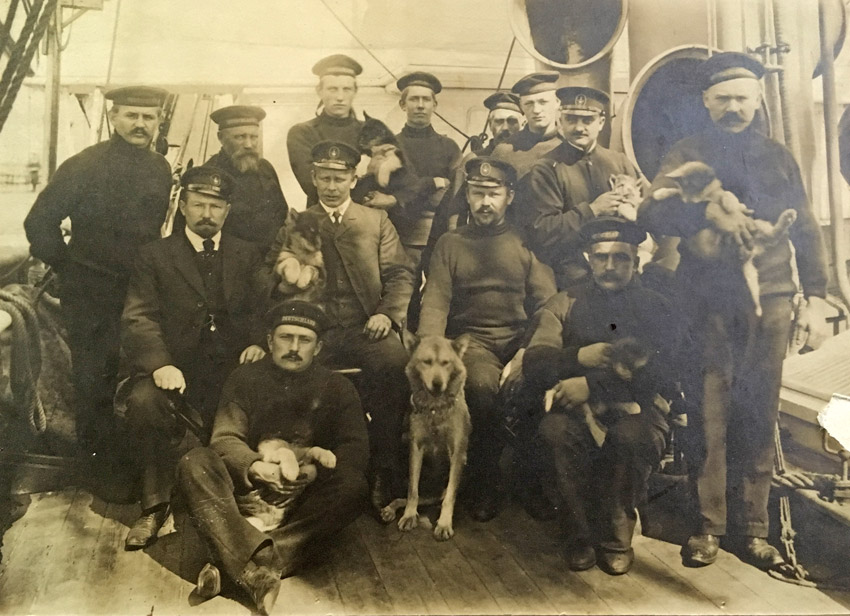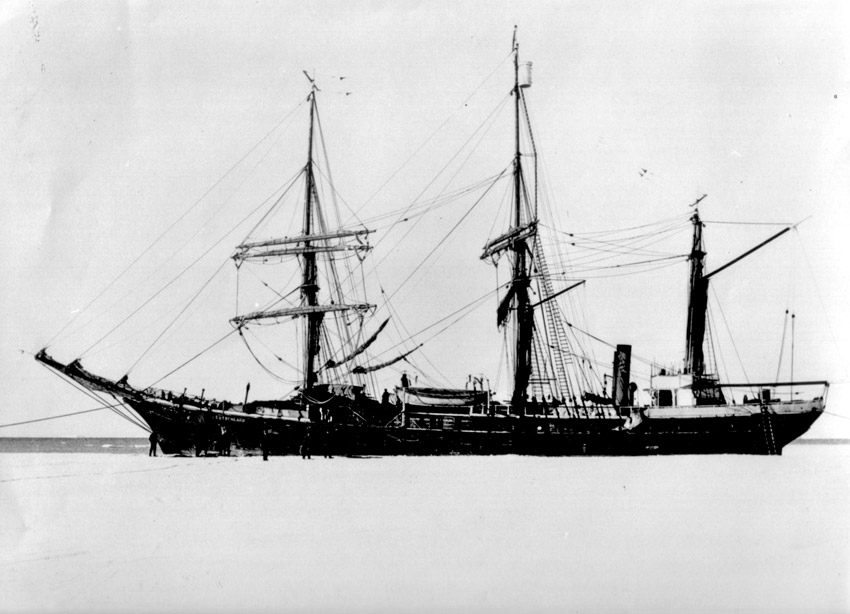Second German Antarctic Expedition 1911-13
Deutschland
- Wilhelm Filchner
The Crew Alphabetically
Barkow, Erich - meteorologist
Bjorvig, Paul - ice pilot, Norwegian
Brennecke, Carl Wilhelm
- Oceanographer
Filchner, Wilhelm -
Expedition leader
Goeldel, Wilhelm - Doctor
Kling, Alfred - Navigator
Kohl, Ludwig - Doctor
Konig, Felix - Scientist
Lorenzen, Wilhelm - First officer
Lysell, Wilhelm - Able seaman
Muller, Johannes - Naturalist
Philipp, Hans - Geologist
Potpeschnigg, Karl - Mountaineer
Przybyllok, Erich - Astronomer and physicist
Mareck, Reinhold - Assistant engineer
Seelheim, Heinrich - Geographer,
second in command
Slossarczyk,
Walter - Third officer
Vahsel,
Richard - Captain
Wolff, Paul
- Able seaman
This list in not complete
The First German National Antarctic Expedition with Erich von Drygalski on the ship Gauss from 1901-03 was one of the mostly highly regarded expeditions of the Heroic Age producing 20 volumes of reports and 2 atlases outlining the findings, the last was published in 1931.
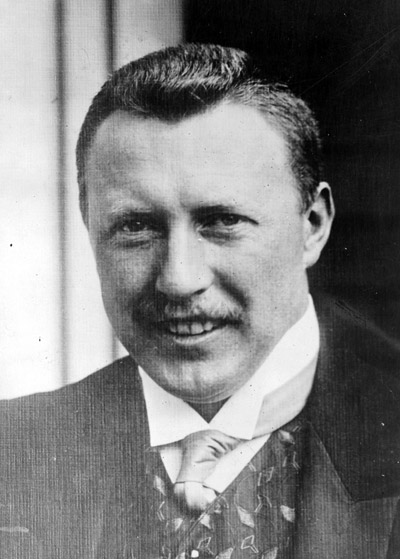 Wilhelm
Filchner Wilhelm
Filchner |
The Second German National Antarctic Expedition however was very different in many ways. It began in disharmony even before the ship had sailed for Antarctica and ended in accusations and recriminations from two competing factions following a mutiny at the end of the expedition in South Georgia and "Courts of Honour" when back in Germany. Richard Vahsel the captain of the expedition ship Deutschland was suffering from syphilis and died during the expedition.
Wilhelm Filchner was a German army officer who had established a reputation as a daring traveller during expeditions on horseback and foot through Russia, China and Tibet. He wanted to build on the reputation of Germany in Antarctic exploration following the great success of the 1901-03 expedition, though he lacked full support from the scientific community in Berlin. Erich von Drygalski, the leader of the earlier expedition was one of his harshest critics, however Filchner managed to get enough support to mount his own expedition.
One of the main aims was to determine if there was a channel which connected the Weddell Sea with the Ross Sea as speculated by Albrecht Penck of the University of Berlin who thought that the then little explored Antarctic continent was comprised of two land masses one to the east and one to the west. An extensive programme of other scientific research was proposed along with the establishment of a land base in a suitable position.
With not insignificant criticism and somewhat lacking in support Filchner had to take help from where it came which contributed to a lack of clarity of who was in charge of the expedition and how important the various aims were. In particular, Filchner agreed to sail under the flag of the German Navy meaning that naval regulations were in operation aboard the expedition ship giving captain Richard Vahsel, a man with a poor and difficult reputation, overall command and authority on the ship. Filchner himself also had a reputation for being authoritative tending to instruct others as to what should happen rather than engaging in discussion. Thus Filchner ended up not being in full command of his own expedition with the Navy seeing it as an opportunity to fly the flag and demonstrate its prowess and skill.
Drygalski (leader of the first German Antarctic expedition) became an opponent of Filchner undermining his authority with the expedition scientists and officers long before he sailed. This position arose in part from academic rivalry between Drygalski and Penck and served to strengthen the position of Vahsel. Overlaid on this was the rivalry in German society at that time between the navy (Vahsel) and the army (Filchner had been an officer), there was a feeling that Antarctic exploration was too important to be left to a mere scientist and that the navy should be in charge, the idea of a naval captain under the command of a scientist as leader caused discomfort to some involved.
Filchner was warned by Hans Ruser captain on First German National Antarctic Expedition
"Do not trust Vahsel and Lorenzen (the appointed first officer)" ..."Particularly Vahsel is a power-hungry person and a dedicated intriguer."
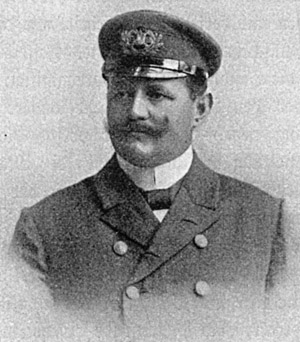 Richard
Vahsel Richard
Vahsel |
The Deutschland left Buenos Aires on the 4th of October 1911 and arrived at South Georgia on the 18th, during the journey an emergency appendectomy was performed on Dr. Ludwig Kohl by Wilhelm Goeldel the other expedition doctor, Kohl remained at South Georgia to recover. While at South Georgia, Walter Slossarczyk the third officer took his life on the 26th of November. After some exploratory trips nearby including to the South Sandwich Islands, they left for the Weddell Sea on the 11th of December. Ice was first met on the 15th of December. Conditions in the Weddell Sea at this time of year can and did change daily from wide open leads to being completely enclosed by ice, fog, snow, shirtsleeves weather and of course freezing temperatures.
On the 30th of December the ship's company consisted of 33 men, 75 dogs (including 37 pups), eight ponies and a cat.
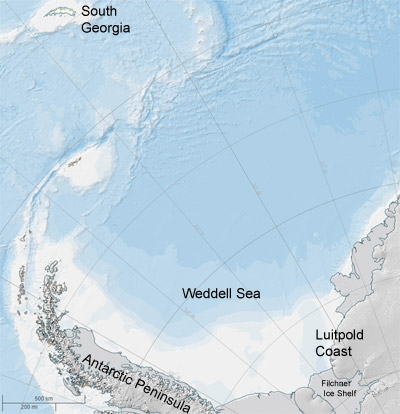 In two weeks at the end of December the ship made 31 nautical
miles, by January the 14th 1912 she was completely trapped in
ice but on the 18th she made 51 nautical miles in one day. On
January the 27th sea floor samples of glacial clay showed the
ship was approaching land, two days later she passed the pervious
farthest south of 74 degrees and 15 minutes in the Weddell Sea
set by Weddell himself in 1823. On the 30th land was sighted,
an ice cliff of about 100 feet high with an ice slope rising
behind it to 2,000 feet. This was new land never before seen
and was named "Prinzregent Luitpold Land" after the
expeditions main patron, this would later become the Luitpold
Coast.
In two weeks at the end of December the ship made 31 nautical
miles, by January the 14th 1912 she was completely trapped in
ice but on the 18th she made 51 nautical miles in one day. On
January the 27th sea floor samples of glacial clay showed the
ship was approaching land, two days later she passed the pervious
farthest south of 74 degrees and 15 minutes in the Weddell Sea
set by Weddell himself in 1823. On the 30th land was sighted,
an ice cliff of about 100 feet high with an ice slope rising
behind it to 2,000 feet. This was new land never before seen
and was named "Prinzregent Luitpold Land" after the
expeditions main patron, this would later become the Luitpold
Coast.
The ship steamed along the ice shelf for several days which Flichner named after Kaiser Wilhelm who himself later renamed it the Filchner Ice Shelf. Vahsel Bay named for the ships captain below the ice shelf was selected to make a winter camp or "Stationhaus" as Filchner called it where scientists were to be left to overwinter while the ship went back to South Georgia. Vahsel, the captain was ill with advanced syphilis, a condition which has been blamed for compromising his decision making abilities.
Stationhaus had a convenient landing ramp and incredible as it seems, was on a known iceberg that at the time was resting on the seafloor. Unloading of supplies, materials dogs, ponies and the construction of a large wooden wintering hut began on the 9th of February and was almost complete by the 17th. At 4 a.m. on the 18th cracking sounds were heard which increased in frequency and intensity until all the ice in the bay began to move and the Stationhaus iceberg was floating and rotating. The iceberg and surrounding ice had been lifted by a combination of a high spring tide and low barometric pressure, a section of ice shelf over 250 square miles had also become detached and Vahsel Bay was now part of a much larger nearby bay. Stationhaus berg started to drift out to sea carrying the construction and seven men, luckily no-one was killed and most of the material was salvaged in an intensive rescue operation over the rest of the day, all that remained was a small quantity of coal and wood and one dog that refused to be caught.
Filchner lost what little command he had of the expedition from that point onwards. Who's decision it was to build the winter quarters at this place on an iceberg and for what reasons are unclear due to a lack of source material. Vahsel, Filchner and Paul Bjorvig the Norwegian ice pilot were involved with Bjorvig later distancing himself and saying that he had advised against it but was disregarded by Vahsel and the scientists for what seemed to be their own reasons of convenience which Filchner went along with though had only been given the partial truth from Vahsel who had spoken with Bjorvig in Norwegian which Filchner did not understand.
The Deutschland now couldn't approach the Luitpold Coast again due to a heavy band of floating ice, after drifting for a few days waiting for the weather to improve a landing was made on continental ice and two large depots were left 330 feet above sea level to be used the following year. Vahsel wanted to get back to South Georgia as soon as possible and didn't want to spend any more time looking for winter quarters. The plan was now for all to return to South Georgia except it was now March and this far south winter was already starting to set in, the ship was completely frozen in by the 6th of March and slowly drifted out into the Weddell Sea, they would be wintering where they were carried with no chance of escaping for several months as would Shackleton on the Endurance three years later in 1915.
Some were not expecting to winter including all of the crew, though they were quite well equipped and made efforts to keep busy. The scientists built small shelters and erected tents away from the ship on the sea ice and busied themselves in a similar way to what they had planned if they had been at Stationhaus. The ship was wired for electric light to keep the dark polar night at bay, there was an extensive library and sporting activities were organized on the deck and the sea-ice though Filchner was little involved as he had fallen from a mast and injured himself.
Filchner led a dog-sledging expedition in late June with Kling and Kohl to find a previously reported sighting of land in 1823 that seemed to now be just 37 miles away, known as New South Greenland, or "Morrell's Land". It was a hard journey. progress was slow with just two to three hours of twilight each day they travelled mostly by moonlight, it was continually bitterly cold which meant that instruments froze up quickly and needed to be thawed out regularly. Sightings of their position took two hours instead of ten minutes and they sometimes covered just a handful of miles a day. After 31 miles the reported land could still not be seen and a depth sounding through the ice reached 5,248 feet before the line broke, they decided they were chasing a mirage rather than a sighting of real land and turned back to the ship. The return journey was more difficult and dangerous than the outward one due the ever shifting ice opening up cracks that had to be skirted round and recently frozen thin ice over recent cracks. On June the 30th they saw the masts of the ship again, lifeboats were sent to collect the men, dogs and equipment as a lead had opened up which had frozen again to form thin ice. The ship had drifted 38 miles while they had been away.
From the 5th of June, Filchner began to record Captain Vahsel's ill health, he slowly worsened and died on the 8th of August, he was buried in the ice shortly afterwards. His command was taken by first officer Wilhelm Lorenzen according to maritime law though his relationship with Filchner was no better than Vahsel's, Filchner never accepted Lorenzen in his new position, eventually the relationship was so tense that they would only communicate through an order book and never face to face. Many incidences through the winter served to increase the divisions on board the Deutschland, at one point Filchner slept with a loaded gun on the cabin floor as he felt in danger of being shot.
The Deutschland continued to drift and by the end of September was floating in a huge open area of water though still surrounded by ice, the boilers were fired up again and the crew prepared for a chance of a break-out which didn't come fully until the end of November with the help of dynamite, they reached South Georgia once again on the 19th of December 1912.
As they sailed into Grytviken harbour fighting broke out on the ship sparked by a rumour the crew might not be paid and fuelled by all the conflicts and aggression the men had suppressed for so long. Captain Larsen from the whaling station took control and explained to both groups the consequences of mutiny to their careers and reputations suggesting that they all concealed the matter and left it behind. Filchner hoped to continue the expedition the following year but was ordered home once descriptions of poor leadership and morale reached the organizing committee back in Germany. Once back Filchner faced a Court of Honour which mainly found him blameless though accusations and denouncements continued, Filchner even challenged the former ships doctor, Goeldel to a duel after he called him dishonourable, an accusation the doctor then withdrew. Eventually the deceased Captain Vahsel was blamed by many for the expeditions numerous shortcomings at least some of which were deserved.
Filchner had had enough of Polar work and turned down two offers including one from Amundsen for further expeditions, returning instead to his previous work in Central and East Asia. He remained largely silent about the events of his Antarctic expedition during his lifetime, writing an expose, "Feststellungen" (Findings) in 1956 a year before his death but with an insistence that it would not be published until 1985.
The Deutschland was sold to Austria and renamed the Osterreich, she was to be used by Felix Konig on an expedition to cross Antarctica via the south pole in an almost identical manner to that proposed by Ernest Shackleton on what would become the Endurance expedition. However when both men offered their ships to their respective countries on the eve of the First World War, while Shackleton received the instruction "Proceed", Konig was ordered to abandon his expedition, the Osterreich was requisitioned for use as a minesweeper and was sunk in 1917.
Despite the problems of the expedition it was a success in that it found new land, the Luitpold Coast and the southern edge of the Weddell Sea. The Filchner Ice Shelf indicated though didn't fully disprove Penck's idea that there was a strait from the Weddell Sea to the Ross Sea and Filchner's winter sledging journey disproved the existence of New South Greenland, or "Morrell's Land".
The scientific results were not written up in expedition reports as was customary due to the antagonism of most of the scientists to Filchner, but they were published by the scientists in their peer groups in the way independent non-expedition research would be. In scientific terms, the expedition was very valuable and productive.
Biographical information
- I am concentrating on the Polar experiences of the men involved.
Any further information or pictures visitors may have will be gratefully received.
Please email
- Paul Ward, webmaster.
What are the chances that my ancestor was an unsung part of the Heroic Age
of Antarctic Exploration?

